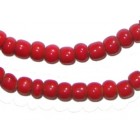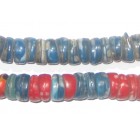Do you ever wonder how certain African trade beads come to get their names? The origins of most African trade beads can usually be determined by their name. For example, Dogon Beads are so called because of their popularity among the Dogon tribe of Bandiagara, Mali. But some, as I’ve recently come to find out, are a little more misleading.

Cornaline d’Aleppo (commonly known as “White Heart Beads“, or “Hudson Bay Beads” in America) were a popular type of wound and drawn trade bead produced between 1805 and the early 1900s in Venice, Italy. Unlike the more elaborate Millefiori Beads and Chevrons, Cornaline d’Aleppo are rather plainer in appearance, comprising just two layers of different colors. The core is usually white or off-yellow, while the outer layer (which wraps the core) is thicker, and ranges in color from burnt yellow to ruby red. A small quantity were also produced in varying shades of blue around the turn of the 20th Century, however, the most coveted were a seductive shade of dark ruby red. According to historical data, the brilliant red of Cornaline d’Aleppo Beads was the result of adding gold oxide to pink or violet glass.
So, how did they get their name? No-one can say with any great certainty why these Venetian Trade Beads came to have such an exotic name, although, it is thought that French-speaking tribespeople in Mali may have had something to do with it. The word “cornaline” is French for carnelian, a type of agate often used as currency among inter-trading tribes in Africa. “Aleppo” on the other hand, is the name of a small town in Syria. Some suggest the reference to Aleppo was inspired by the fact that it was once an important trading post between Africa and Asia. Nomadic African tribespeople would pass through the city to stock up on supplies, exchanging carnelian beads for essentials such as furs, tools and food. I prefer to believe the name derives from the magical striped stones of Aleppo, famous throughout Africa and Asia for their healing properties.
